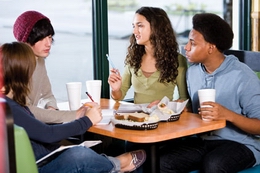 Showing diners how many calories are in restaurant food items may influence how much they eat - especially among the least health-conscious people, a new study suggests.
Showing diners how many calories are in restaurant food items may influence how much they eat - especially among the least health-conscious people, a new study suggests."It's encouraging because the information may help the people who will need it the most," said Lorien Urban, who has researched menu labeling at the Jean Mayer USDA Human Nutrition Research Center on Aging at Boston's Tufts University.
Previous studies have found that people tend to eat less when they are told how many calories are in their food, but scientists have not looked at how that breaks down across different types of diners.
For the new study, researchers randomized patrons at a restaurant on the Oklahoma State University campus to use one of three menus during a two-week period in late 2010.
One group of diners received standard menus without calorie information, another group got menus showing each item's calorie count and the last group got a menu featuring traffic light symbols representing calorie counts.
A green light was printed next to foods with less than 400 calories, yellow lights next to foods with between 401 and 800 calories and red lights next to foods with over 800 calories.
By the end of the meal, diners ordering off the standard menu ate -- on average -- 817 calories. That compared to the 765 calories people ate when they ordered off the menu with printed calorie counts and the 696 calories they ate when ordering
Although that is only a difference of 52 calories and 121 calories between the standard and experimental menus, the study's lead author said that can add up over time.
Depending on the person, cutting 121 calories per day would lead to about a one-pound weight loss over a month.
"It could be substantial if that reduction persists every time you went out to eat, but as a one term reduction it might not be effective," said Brenna Ellison, of the University of Illinois at Urbana-Champaign.
Based on customer surveys, Ellison and her colleagues from the Oklahoma State University found that the least health-conscious people seemed to cut the most calories in response to the experimental menus.
Those people, the researchers write in the International Journal of Behavioral Nutrition and Physical Activity, are "precisely the people that menu labeling laws are often trying to influence."
Ellison told Reuters Health that health-conscious people might not pay as much attention to calorie information because they're already well informed about nutrition.
Regardless of how health-conscious people were, the researchers found the traffic light menu seemed to have the strongest calorie-cutting influence.
"I think it's in line with what we've seen that interpretive information is helpful," said Urban, who was not involved in the new study.
Under the 2010 Patient Protection and Affordable Care Act, certain chain restaurants must list their foods' calorie information on their menus.
Previous research has found restaurants that are forced to disclose how many calories they're serving customers end up changing their menus.
Ellison said listing calories is just one approach policymakers are looking at to encourage diners to lighten their load.
"The way it's looking is it's going to take several methods," she said.





